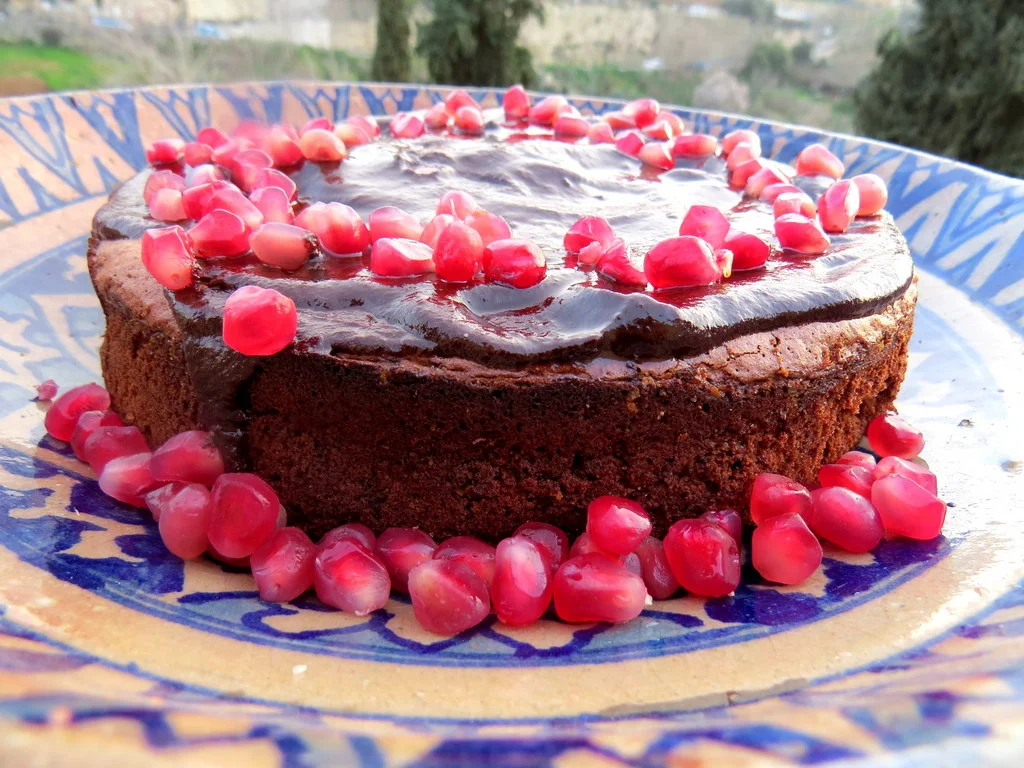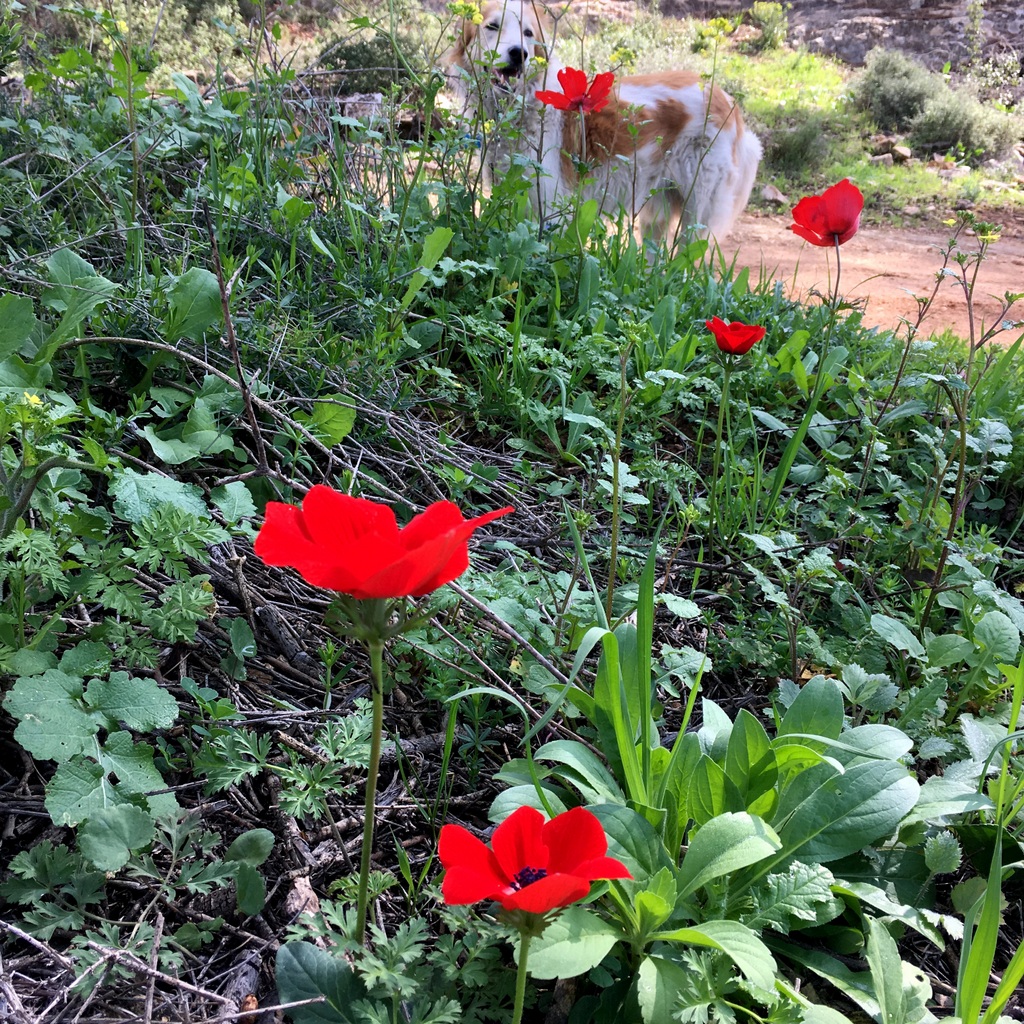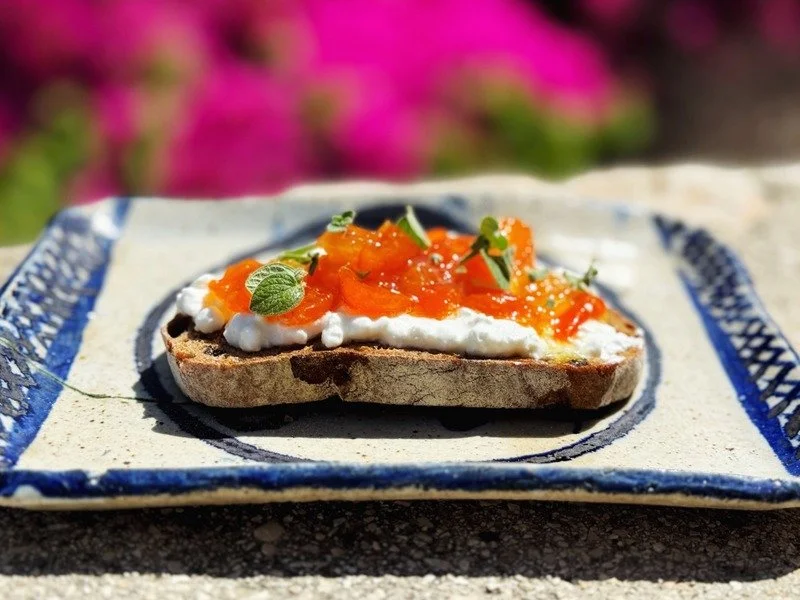One Year Ago - Duck Baked with Garlic & Honey
The fake winter is winding down into a shiny spring filled with cyclamens and anemones.
As I walk the dogs through the Judean hills near my home, absolute heaven at this time of year, I’m horrified by how much rubbish there is and have started photographing what I see, and manage to carry out. (You can check out #trashphotochallenge on my FB page.)
I will add more on this in later posts, just buttering you up with dogs and flowers to start with. And cake!
Have been baking a lot lately, this is the chestnut cake I promised you back in December, before Omi Mitzi’s fruit cake and Elizabeth’s cheese and sour cherry strudel muscled their way in. This makes an excellent third to round off this high-flying very European trio.
This cake is gluten free, and is both dense and light at the same time, an apparent contradiction, but that's the only way to describe it. You may not be able to identify the taste of chestnuts, but you do know it’s not a usual chocolate cake… and a very delicious one!
The 2 recipes below are almost identical, except that one is dairy free. The dairy free version is a torte, and the recipe comes with a cream filling and a chocolate sauce.
EVA GRINSTON
It’s the recipe of Eva Grinston, a Holocaust survivor from Sydney, a great cook and a stellar baker. Confession: Eva is the mother of one of my dearest friends and I began this project with her. She's a wide-ranging cook and when we chat, we divide her recipes into “from Granny’s book” or “from elsewhere…” (which could be Eva's Hungarian cookbook, or from a friend, or a neighbor, or knowing Eva from Ottolenghi too. She is very adaptable, and up to the minute.)
But the recipes from Granny’s Book are the ones I treasure the most, for Granny’s Book is a book with a story.
First of all it is literally Eva’s Granny’s book, in her hand-writing, with her own recipes and those of her friends. (And with Granny’s notes in the margin after she’s tried to bake her friend’s dishes -- Good / Not so good - she never gives you all the ingredients etc.)
BRATISLAVA
Eva’s Granny lived in Bratislava, the capital of Slovakia, where Eva was born in 1930. According to the 1940 census, there were almost 90,000 Jews in Slovakia. It’s estimated that in 1945, at the end of World War Two, less than 30,000 remained alive. Two thirds had been murdered, including Eva’s mother, her aunt Susan and her little sister Vera. (Eva’s Granny had died of natural causes before the War began.)
Eva's younger sister Vera Silbestein, and her mother Elisabeth Silbestein. Both perished in Auschwitz in late 1944, approxinately 2 weeks apart.
Eva can’t explain to you how it was that she survived when her mother and sister did not. They were all together in Bratislava’s Jewish ghetto until the Nazis invaded Slovakia in autumn 1944. As transports to the death camp of Auschwitz resumed, Eva’s mother Elisabeth found a hiding spot for the girls. The caretaker of their old apartment, who had loved and admired her grandparents, was prepared to hide them, at great risk to himself.
Within weeks, their mother was captured, along with her sister. A week later, the girls were captured too. Eva believes they were betrayed to the Nazis.
Eva by then aged 15, and her sister Vera just 13, were terrified, but Eva admits they were also relieved because they thought it meant they would see their mother again. It was a childish hope, and it didn't happen. It couldn't. When their mother and aunt had been taken a week earlier it was to Auschwitz. They had been murdered on arrival.
Eva and Vera were packed onto a train that usually transported animals, with hundreds of other Jews from their town. After four days journey without food or water, they were pushed out into mayhem. Thousands of people, men and women, old and young, sick and strong were surrounded by armed soldiers with dogs. There was shouting, and the sound of whips cracking. This was Nazi occupied Poland. They too were at the death camp of Auschwitz.
Selection ramp Auschwitz May 1944, a few months before Eva was transported here with her sisiter Vera. Photo believed to be taken by 2 Nazi officers working at the death camp. They left more than 150 photos behind in an album, which was picked up by a Survivor at the end of the War. 18 yo Lily Jacob saw photos o f her relatives there and kept it. She donated the album to Israeli Holocaust Memorial Yad Vashem in 1980.
AUSCHWITZ
The girls looked for their mother. She wasn’t there, of course. There was one person waiting for them -- a dark-haired German officer. Dr Josef Mengele was a medical doctor, an SS officer, and a sadist. He supervised the ‘selection’ of new arrivals, deciding who was to be killed immediately in nearby gas chambers and who could do forced labour, and would be killed later.
Eva looked like a young woman, Vera still looked like a child.
He separated the 2 sisters. Eva’s final image is of the back of Vera’s head disappearing into the line on the other side of the platform.
“My mother held onto her sister, and I did not hold onto mine,” she says sorrowfully.
Eva was now alone in this most terrible place. Her head was shaved; she was tattooed, disinfected and put to work.
This photo shows young Jewish women selected for slave labour at Auschwitz in May 1944. It s also from the photo album which Lily Jacob found at the death camp the end of the War.
Eva was told what else went on there: the wholesale murder of civillians … and she couldn’t believe or comprehend it. But over 2 months, she saw thousands of innocent people being killed each day, and became a witness to industrial-scale murder.
She too might have been killed but it was late in the war. The tide was turning against the Nazis, and at that point, Eva was more valuable to them as a slave labourer. She and other female prisoners from Auschwitz were loaded onto trains and transported to the German capital Berlin.
During WW2, Daimler Benz did Nazi war work. Luxury cars were put on hold, and the company manufactured aircraft at its Genshagen plant near Berlin. They used slave labour. Eva Grinston was one of those labouring there in early 1945, on an underground assembly line. She was 15 years old.
At the nearby Daimler Benz plant at Genshagen, now manufacturing aircraft instead of luxury cars, Eva tightened bolts on propellers. The women never saw daylight. Above their heads, the Allies bombed Berlin.
As the war was ending, the female prisoners were transported to the Ravensbruck concentration camp. After Hitler's suicide, the Nazi guards fled, and so did most of the prisoners. But Eva was too ill to move. She had contracted typhus and was lying near death when Russian soldiers entered the camp on May Day 1945. "My liberators nursed me and the other sick women back to health," says Eva.
GOING HOME
Eva was a gaunt bereft 16-year-old when she returned to Bratislava. She found her family home still standing, with Russian soldiers billeted there. They gave her 15 minutes inside and said she could take whatever she could find.
Eva saw that that very little remained of her past. But in the cellar, she discovered a box which her mother had hidden before the family was forced into the ghetto. In it, there was a kaleidoscope Eva had played with as a child, and the last drawings her sister Vera had done before they were taken to the ghetto.
Some of her sister Vera's drawings, which Eva discovered in a box in the cellar of her former home when she returned after WW2. Vera would have been 12 years old when she drew these.
And there was her grandmother’s cookbook.
REFLECTION
Eva describes leaving her old family house and sitting on the outside fence, as she had when she was a little girl, and lifting her kaleidoscope to the sky. It was still working. She saw the images of her happy early life -- her Granny, all the members of her family, she saw the faces of the ladies who visited Granny, and the children she played with as a child.
“My face was wet with tears. I had no hanky. I opened the cookbook and there were the recipes of my Granny, and Granny’s friends,” says Eva.
She’s been cooking from it ever since, a link to her past, and as she cooks from it for her grandchildren, also to her future.
MEMORY
Eva protected her children, and later her grandchildren, telling them stories from her happy early life, and bearable stories from the Ghetto, but little about her terrible experiences in the death camps.
Still, they were affected, as Eva herself was never free of her war time experiences. Firstly, there’s a permanent reminder inked on her skin – the prison number the Nazis tattooed onto her forearm at Auschwitz.
Then every year on 6 May, her sister Vera’s birthday, Eva raises a toast to the feisty, passionate sister she lost in Auschwitz, and tries to imagine what she would have been like had she survived.
Her positive memories emerged in the kitchen, when Eva cooked from her Granny’s cookbook. Her husband Michael, who knew how much it meant to her, would open the cookbook at random, point to a recipe and say make – "Can you make -- that one?" Eva still smiles as she tells this story.
Her son John loved cooking with her when he was growing up, and now her grandchildren do.
Eva cooks with her grandson Nicholas Rice.
She loves that, for continuity is important to Eva.
“I want them to remember that there is a link with Europe in our family and I guess to not let the past die really, because it was beautiful while it lasted,” Eva says.
CHESTNUTS
There are still fresh chestnuts in the stores and this turned out to be a lovely Valentines Day treat. It is lighter than the dairy version below, but the chestnuts give it a pleasing denseness.If you are using fresh chestnuts, go back to the Food is Love Chestnut Soup post for a quick description in how to score and roast them. This really is vital, since if you don’t they will explode in your oven!
If you don’t have the time or patience, and are in the wrong hemisphere, so there aren’t any fresh right now, then simply buy them pre-roasted in a vacuum bag (the second best option to roasting your own). You can also buy them pureed in a tin, but check to make sure they are not sweetened. You don’t want chestnuts in sweet syrup, or sweetened chestnut puree.
As usual, I have reduced the amount of sugar from the original recipe. The recipe also called for 20 g breadcrumbs, which I forgot and didn’t miss at all, so I have omitted that.
dairy free
This cake is gluten free, and its other advantage is that you can make it dairy free as well - see below for how to make the chocolate topping with coconut milk I hope Eva's Granny would approve!
Eva’s Chocolate Chestnut Torte
INGREDIENTS
4 eggs at room temperature
1/3 cup sugar + 1 tablespoon sugar, extra
¼ teaspoon cream of tartar
125 g /4 oz roasted chestnuts, pureed – shelled weight (or 125 g tinned chestnut puree, not sweetened)
125 g / 4 oz dark chocolate, 60% or higher, melted
Small cake tin – 8 inch / 20 cm
TOPPING
300 ml cream, plus 1 tablespoon sugar
200 g dark chocolate
40 g butter
4-5 teaspoons of milk, or black coffee
METHOD
1. Roast and peel chestnuts. Reserve a few for decoration, then mash with a fork or puree in food processor. A blender is not good for this job. (It’s the wrong shape and you end up with gummy clumps of chestnut, on the way to chestnut butter… ) You can add 1 teaspoon of vanilla, or 1 tablespoon of brandy or rum.
2. Melt chocolate in the top of a double boiler. You can also use a micro-wave for this step. Keep the temperatures low, you want it to be a slow process.
3. Separate eggs. Using an electric mixer, beat whites with ¼ teaspoon cream of tartar. Add 1 tablespoon sugar towards end when it is becoming glossy, to help it along. Set aside.
4. Beat egg yolks with 1/3 cup till light, about 5 minutes. Add pureed chestnuts, melted chocolate and finally fold in the firmly beaten egg-whites.
5. Pour into a floured round tin, bake in medium oven, 180/360 degrees, 30 minutes. Don’t let it get super-dry. The toothpick you insert should still have moist crumbs clinging to it.
6. When cool, beat cream with sugar, split cake in 2 and spread cream on bottom half. Place other half – carefully! – back on top. Reserve any left over to serve with the cake. Omit this step if you are making a dairy free cake.
TOPPING
7. In the top of a double-boiler, melt chocolate, butter and milk or coffee. When it’s smooth, taste for sweetness, add sugar if you feel it’s needed. Let cool slightly, and pour over cake before the chocolate sets.
8. Decorate with a few reserved chestnut pieces, or pomegranates or strawberries for a contrasting colour.
DAIRY FREE CHOCOLATE SAUCE
100 g dark chocolate, 60 % or higher
400 g tin coconut milk, use 1/3 of the tin
METHOD
1. Melt chocolate in a double boiler, set over a low flame. Add 1/3 of the coconut cream. By accident, I didn’t shake the can… and so used only the creamy bit from the top. That turned out to be a great move, giving it a beautiful consistency. So use the most solid part of the creamed coconut and mix into the melted chocolate. You can do this on or off the heat.
2. When smooth, pour over cake. Serve with coconut yoghurt.
VERDICT: This is a great cake, light and dense at the same time. I didn’t split it and put the cream inside, since I was trying the dairy free chocolate, and didn’t have a suitable substitute for cream. (Jerusalem is low on coconut yoghurt, which I love, and big on dairy free-cream, which I don’t.)
This torte does need something to cut that chocolatey feel, so I ended up serving it with sheep's milk yoghurt beaten with vanilla.
THE FULL MONTY
If you don’t have time to decorate the cake with cream and chocolate topping, or you have to take the cake somewhere, this dairy version is richer and can stand alone, with sieved icing sugar and a little cream on the side. Otherwise, these 2 cakes, one from Eva’s Granny in Slovakia and the other from American baker and chocolate maven Alice Medrich, are almost identical.
Chocolate Chestnut Cake – Dairy Version
INGREDIENTS
4 eggs, separated, at room temperature
125 g / 4 ounces dark chocolate
110 g/ 1 stick butter
3/4 cup (about 180 g / 6 ounces) pureed chestnuts
1 tablespoon rum or brandy
1 teaspoon vanilla paste or extract
1/2 cup sugar
1/4 teaspoon cream of tartar
300 ml carton cream, whipped
METHOD
1. Place the chocolate and butter in the top of a double boiler till melted. You can remove it before it’s completely done, and stir it till melted. It’s better underdone! You can also do this step in the micro-wave. Stir till completely smooth. TIP: Use a large pot or bowl, so you can do all your mixing in this one bowl.
2. Stir the chestnuts, rum, vanilla, and a pinch of salt into the melted chocolate. Add the egg yolks, along with ¼ cup sugar. You can use a whisk or a wooden spoon.
3. Beat the egg whites and cream of tartar. When soft peaks form, add 2 tablespoons sugar and beat till glossy. Fold into the cake mix.
4. Pour into an 8 inch / 20 cm cake tin. Bake for 20 - 30 minutes. Don’t let it get super-dry. The toothpick you insert should still have moist crumbs clinging to it.
5. To remove, slide a knife around the inside of the cake tin. Sift powdered sugar over the cake to serve, if you like. Serve with whipped cream.
VERDICT: I made this because I wanted a cake that I didn’t have to decorate to take to a friend’s home, after her mother had passed away.
It is also a winner! It has a fudgy consistency, almost like a soufflé. I forgot to add any sugar to the cake mix (though I did add it to the egg whites) and that gave it a not too sweet, very adult taste. You can reduce the sugar in this recipe and still be happy.
VALENTINE’S DAY
I want to add a moving Valentine’s Day story from American writer and poet John Guzlowski. I encountered him and his stunning poetry on a FB page for children of Holocaust survivors, though he is the son of Catholic Poles. His parents were taken to Nazi Germany to work as slave labourers during World War Two. John has written a series of searing poems about his parents, and the experience of being “2G” in a book called Echoes of Tattered Tongues: Memory Unfolded.
You can see his poems here on his website, or follow him here in his FB group, also called Echoes of Tattered Tongues.
I plan to feature more stories and poems from this amazing work. I love this seasonal offering.
A Valentine's Day Story -- How My Parents Met in a Slave Labor Camp
John Guzlowski
My mom had been brought to Germany to work in a slave labor camp. The day she was captured she saw her mom and her sister and her sister's baby killed by German soldiers. My mom was crying so much when she got to the camp that one of the guards said if she didn't stop crying they would shoot her.
Near the end of the war, my dad and some other slave laborers were brought to my mom's camp by German guards who were escaping the Russians. The Germans left him there and fled toward the American lines. When my mom saw my dad, he was a scarecrow in rags. He weighed about 70 pounds and had only one eye. He had lost the other when a guard clubbed him for begging for food.
She was 23, he was 25. She had been a slave for 2 years, he had been one for 4.
When I would ask my dad what it was like when they met, he would smile and say, "First we had something to eat. Then we got married." My mother's version was a little more complete. Here's the way she told the story in a piece from my book about them, Echoes of Tattered Tongues: Memory Unfolded.
My Mother Tells Me How She Met My Father
I first saw him in front of the barracks. He was walking with six other prisoners, a German soldier behind them pushing at them with some kind of rifle. Your father wasn’t how he is now. He was skinny then, like two shoelaces tied together.
I was not such a prize after three years in the camps either. When the Americans came, they weighed me and found I was less than 100 pounds—and what was I wearing? You want to know? Woolens on my legs, a gray rag to hide my hair, a striped dress.
And him? Your father? Like I said, skinny with a bleeding towel across his face from where he lost his eye.
Still, he walked up to me, took my hand, and said in Polish, “Proszę, pani.”
Yes, he said, “Please, miss,” and like a proper gentleman, he clicked his heels. I thought he was at least a count, maybe a prince.
Then just before your dad had a chance to kiss my hand, the German behind him kicked him in the pants and said, “Dummkopf, raus!” Get moving, dummy!
Your father was like that. Always putting on airs, even then in the camps talking of Polish honor as if he and Poland shared a soul.
Really, he was worthless. I wish he had left me there in the camp. He couldn’t drive a car, he couldn’t fix a leaky roof.
When I asked him in the refugee camp to help me pack to come to America, he took a little drink and bundled all the clothes together in a bedspread like America was across the street.
The fool, I should have kicked him like the German soldier did when I met him.
Instead, I kissed him and wept.







































